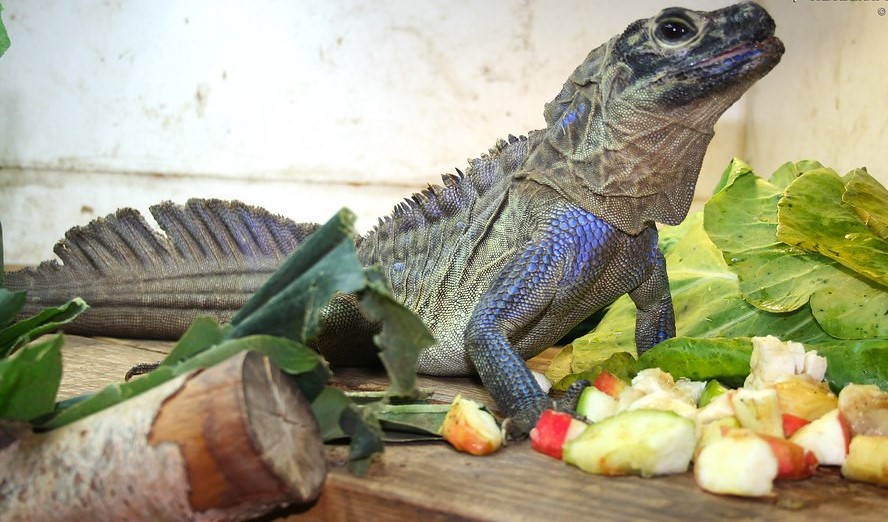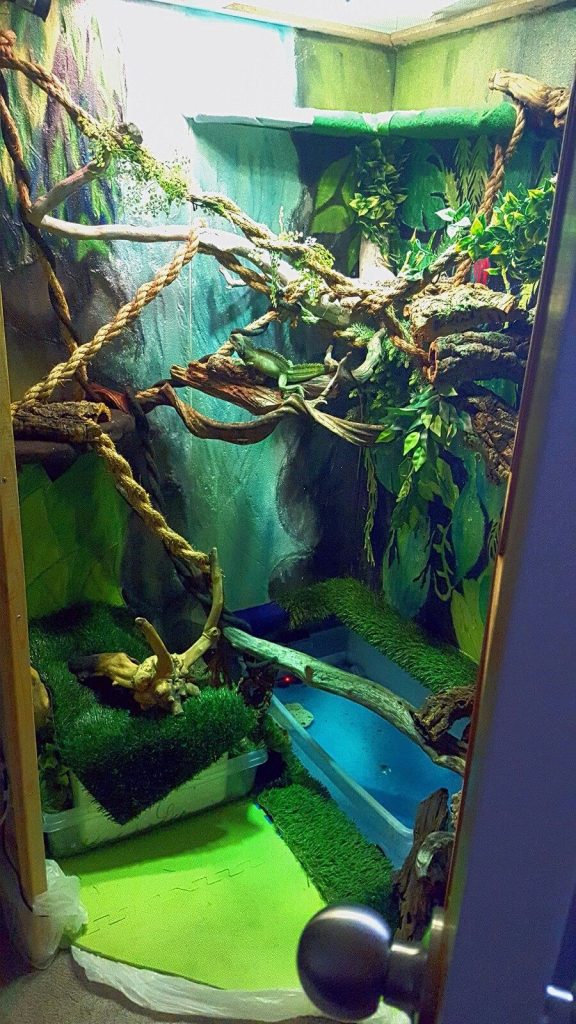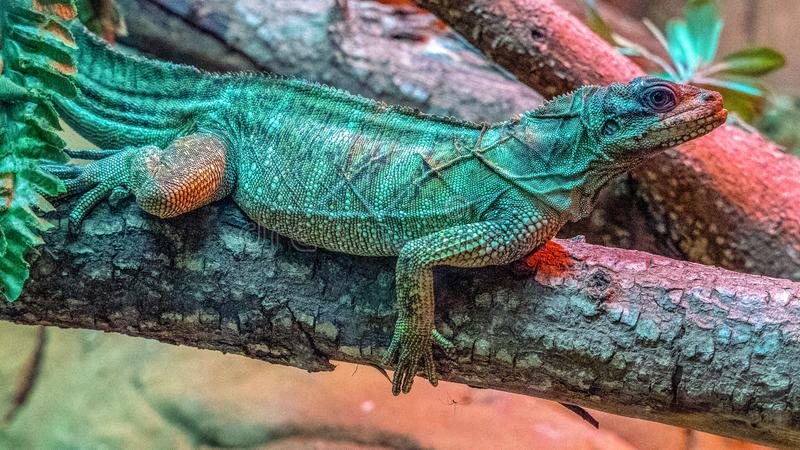A rare species of lizard native to the Philippines and Indonesia is called a sailfin dragon. These dragons feature vivid colors, a long “sail” down their back, and a maximum length of roughly three feet.
For these lizards to be kept in captivity, a significant degree of expertise and dedication were needed. Regrettably, the exotic pet industry and the degradation of their habitat have made several species of sailfin dragons vulnerable.
Types of Weber’s Sailfin Dragon
The largest lizards in the Agamidae family, which includes lizards that resemble iguanas, are called Hydrosaurus. It is a favorite among people looking for a distinctive pet due to its dinosaur-like appearance and distinctive physical attributes.
The Hydrosaurus genus contains three recognized species- Sulawesi big sailfin dragon, Makassar sailfin lizard, or Indonesian giant sailfin dragon are all names for Hydrosaurus microlophus.
The Hydrosaurus pustulatus, also known as the Philippine sailfin lizard, sailfin water lizard, or soa-soa water lizard, is the following. The Weber’s sailfin lizard, Hydrosaurus weberi, is the last.
Natural Habitat

Eastern Indonesia, the Philippine Islands, and southern New Guinea are the natural habitats of the sailfin dragon. Tropical forests with silty rivers are the lizard’s native habitat.
In their heavily vegetated habitat, sailfin dragons spend the majority of their time basking in or near the water, scaling tree limbs, and foraging for leaves, fruits, insects, and small animals.
The world’s parched and arid regions are home to lizards as well as tropical rain forests and rainforests. Numerous elements, including light, heat, humidity, tension, nutrition, and hydration, have an impact on the health and happiness of your lizard.
Sailfin dragons are nocturnal, which means that they have a regular pattern of day and night and spend the nighttime under rocks and logs.
Diet in Captivity

Sailfin dragons consume almost anything that is known to be nutritious and palatable. Infants should be given as frequently as they feel hungry. Sailfin dragon food is typically insects, leaves, flowers, fruits, and small animals.
In captivity, replicate this diverse omnivorous diet by offering a mix of insect- and plant-based foods high in protein.
Sailfin Dragons are omnivores. Pellets made for bearded dragons by businesses are a great compliment. Try giving more gut-loaded, dusted insects as dusk falls.
Maintain the same food, dietary supplements, and calcium-dusted invertebrates as sailfin dragons mature, but increase variety by including small mice, ground turkey, clean crustaceans, seafood, shrimp, and crawfish.
If maintaining ovulating females, increase the calcium intake, and add vitamins once or twice a week to the diet.
Regular offerings of roaches, earthworms, crickets, butterworts, silkworms, super mealworms, and other readily available invertebrates are advised. There should also be cicadas, beetle, grasshopper, moth, and various other captured wild insects available.
Sailfin Dragons are mainly carnivorous as juveniles, but as they get older, they also eat fruit and vegetables. However, captives frequently refuse non-living foods. Live mealworms added to a salad of kale, dandelion, zucchini, carrot, mango, peaches, and other fruits and vegetables may entice them to try the dish.
Social Behavior
The shy, cautious sailfin dragons are impressive when it comes to having hiding and escaping skills that they use whenever they sense danger.
Since they feel that the water is the safest location for them, they frequently dive in. Every time they sense danger, these reptiles will look for water.
They will swim and descend far beneath the surface of the water in quest of a rock or piece of driftwood that they can use as cover.
When they are certain the threat has passed, the sailfin dragons will remain under the surface for up to 15 minutes or even longer.
A sailfin reptile is not a pet for novices. They are fearful lizards who will charge the walls of their enclosure if they perceive a threat. Their snouts could easily be harmed by this.
Since sailfin dragons are not accommodated along with other members of their species, they should be housed in separate enclosures. Only one male sailfin should be kept in each cage because they can be violent toward one another.
Socializing of sailfin dragons should start at 4 weeks old in order to tame them. The best outcomes come from doing it daily.
These lizards can become too wild and much more sensitive to stress when interacting with people if they haven’t received the appropriate socialization.
Reproductive Habits
The sexual breeding method is used by Philippine adult sailfin dragon lizards, who only mate once a year and may have several clutches of eggs.
Few accounts of sailfin dragons being successfully bred in captivity exist due to the lack of maternal instincts in females and the challenge of simulating the rainy season inside an enclosure.
When the reptiles are 3.5 to 4 years old, they become sexually mature.
Female Sailfin dragons only reproduce once a year, but they may then deposit numerous clutches of 2–8 eggs in a small hole dug in the ground near a river.
The eggs take about two months to mature, and when they do, they are busy and agile enough to evade any possible predators. Wild Sailfin dragon hatchlings are adept swimmers, just like the adults, and will easily flee to the water if danger approaches.
Threats
Sailfin dragon’s primary risks include the destruction of habitat, food-related hunting, and capture for the pet trade. The pet trade, exotic meat hunting, and habitat decline are some of the elements causing this fragile conservation state.
Lowland, coastal, and mangrove forests—the habitats needed by large-bodied sailfin lizards—have seen their populations decline, leaving them with less space to exist. In the past 75 years, the deterioration of the coastline’s forests and mangroves has led to the decline of over 75% of the original woodlands.
When the environment is appropriate, these lizards can be found in great numbers, but they are absent from other locations. In addition to being exploited in the worldwide pet trade, these lizards’ utilization in these forests has raised the need for more aggressive conservation measures.
Conservation
The IUCN has recently downgraded the status of Philippine sailfin dragons to the least concern. Loss of habitat, hunting for exotic meat by collectors, and the pet trade are all elements that contribute to this vulnerable conservation state. Numerous factors work against the conservation attempts of this genus. Illicit pet traffic is one of the main problems.
Although some exotic pet collectors assert that they are currently in the custody of these lizards and have bred them in captivity for sale to customers in the United States of America, it is presently illegal under Philippine law to ship the reptiles outside of the nation.
It is crucial that conservation attempts to establish Philippine sailfin lizard protected areas take place in their natural habitats rather than these trading areas. In terms of the origins of the pet trade, Philippine sailfin lizards had been more frequently sold between 1980 and 1990 due to the Philippines’ international exportation of these reptiles.
However, the Philippines no longer exports these lizards, so Indonesia is now the leading exporter of these animals.
Sailfin Dragon Care Guide
Sailfin dragons, also known as the crest dragon, are a species of large, tropical lizards native to the South Pacific. Due to their exotic appearance and comparatively simple maintenance needs, they are common pet reptiles. As an intermediate diversity, sailfin dragons are not recommended for beginner keepers.
Enclosure Size

A safe enclosure is of great assistance in this. The enclosure will help to prevent the frequent nose-rubbing that happens with these lizards. Large-size enclosures are essential for Sailfins once the juvenile stage has passed.
Keep larger juveniles and adults in cages designed specifically for their unique semiarboreal needs. Give your sailfin dragon, a minimum enclosure size of at least 5 feet long, 2.5 feet wide, and 5 feet tall. 5′ x 5′ x 6′ would be big enough for the lizard.
If you plan to house more than one animal, be sure to increase the enclosure’s length and width by a few feet.
Keep your sailfin dragon in a cage that will keep more heat and humidity, which is necessary for healthy growth and shedding, and your dragon will feel safer.
Avoid pursuing your sailfin dragon inside its enclosure setup since it can become more frightening. Sailfin dragons require enormous enclosures that are at least several feet long due to their size.
You can also put plants in the enclosure. Plants will improve the habitat’s aesthetic appeal within their enclosure.
Lighting
Sailfin dragons need UVB light for 10 to 12 hours a day in order to stay healthy. Additionally, a spot for basking should be provided using an incandescent lamp.
Temperature and humidity level
Since sailfin dragons have developed to coexist with water, an enclosure must have a humidity level of at least 75%. Another crucial component of the cage is a sizable water pan that is deep enough for the lizard to submerge.
Both a good UVB light source and basking bulbs for heat are crucial. Since these animals are native to tropical climates, the enclosure temperature should hover around 115 degrees Fahrenheit.
To keep one-half of the enclosure warm enough for these lizards, keepers must spend money on items like ceramic heat emitters and red lights. Mist the enclosure on a regular basis too.
Remember, it’s critical to regularly check the humidity inside the enclosure.
However, in a few cases, temperatures are between 74 and 82 degrees Fahrenheit during the day and 72 F at night because sailfin dragons are prone to respiratory diseases.
Substrate
A substrate made of organic materials that can withstand high humidity is required for sailfin dragons. Cypress Mulch is particularly effective. Although it is cheap, be sure it is only pure cypress mulch and not a blend.
Is Sailfin Dragon Good Pet?

Sailfin dragons should not keep as pets by beginners. It is difficult to take care of a sailfin dragon because it’s tenser than other lizard species like iguanas, despite the fact that they tend to be calmer when handled frequently.
And you might also have to keep a continuous eye on your lizard inside the enclosure.
Conclusion
Before getting a Sailfin, learn how to care for one. Go online for reliable breeders to find a healthy sailfin dragon for sale. Ask to see photos and videos of the lizard prior you spend any money.
Verify the lizard’s eating habits, bright eyes, and perfect skin. Contact reptile enthusiasts if you want to learn further!
FAQ’s
What do sailfin dragons need?
Due to their ongoing need for care and attention, sailfin dragons are exceedingly difficult to keep. You must check on them as frequently as you can because of their everyday behaviors, including pooping in their water bowls.
What do sailfin dragons eat?
As omnivores, sailfin dragons eat a wide range of insects, spiders, worms, small vertebrates, fruits, and plants in their food.



